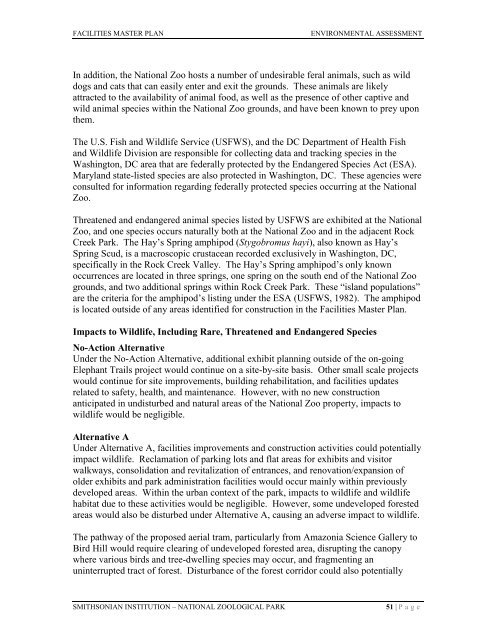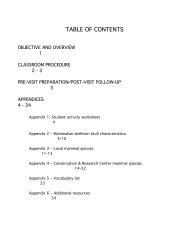facilities renewal master plan - National Zoo - Smithsonian Institution
facilities renewal master plan - National Zoo - Smithsonian Institution
facilities renewal master plan - National Zoo - Smithsonian Institution
You also want an ePaper? Increase the reach of your titles
YUMPU automatically turns print PDFs into web optimized ePapers that Google loves.
FACILITIES MASTER PLAN ENVIRONMENTAL ASSESSMENT<br />
In addition, the <strong>National</strong> <strong>Zoo</strong> hosts a number of undesirable feral animals, such as wild<br />
dogs and cats that can easily enter and exit the grounds. These animals are likely<br />
attracted to the availability of animal food, as well as the presence of other captive and<br />
wild animal species within the <strong>National</strong> <strong>Zoo</strong> grounds, and have been known to prey upon<br />
them.<br />
The U.S. Fish and Wildlife Service (USFWS), and the DC Department of Health Fish<br />
and Wildlife Division are responsible for collecting data and tracking species in the<br />
Washington, DC area that are federally protected by the Endangered Species Act (ESA).<br />
Maryland state-listed species are also protected in Washington, DC. These agencies were<br />
consulted for information regarding federally protected species occurring at the <strong>National</strong><br />
<strong>Zoo</strong>.<br />
Threatened and endangered animal species listed by USFWS are exhibited at the <strong>National</strong><br />
<strong>Zoo</strong>, and one species occurs naturally both at the <strong>National</strong> <strong>Zoo</strong> and in the adjacent Rock<br />
Creek Park. The Hay’s Spring amphipod (Stygobromus hayi), also known as Hay’s<br />
Spring Scud, is a macroscopic crustacean recorded exclusively in Washington, DC,<br />
specifically in the Rock Creek Valley. The Hay’s Spring amphipod’s only known<br />
occurrences are located in three springs, one spring on the south end of the <strong>National</strong> <strong>Zoo</strong><br />
grounds, and two additional springs within Rock Creek Park. These “island populations”<br />
are the criteria for the amphipod’s listing under the ESA (USFWS, 1982). The amphipod<br />
is located outside of any areas identified for construction in the Facilities Master Plan.<br />
Impacts to Wildlife, Including Rare, Threatened and Endangered Species<br />
No-Action Alternative<br />
Under the No-Action Alternative, additional exhibit <strong>plan</strong>ning outside of the on-going<br />
Elephant Trails project would continue on a site-by-site basis. Other small scale projects<br />
would continue for site improvements, building rehabilitation, and <strong>facilities</strong> updates<br />
related to safety, health, and maintenance. However, with no new construction<br />
anticipated in undisturbed and natural areas of the <strong>National</strong> <strong>Zoo</strong> property, impacts to<br />
wildlife would be negligible.<br />
Alternative A<br />
Under Alternative A, <strong>facilities</strong> improvements and construction activities could potentially<br />
impact wildlife. Reclamation of parking lots and flat areas for exhibits and visitor<br />
walkways, consolidation and revitalization of entrances, and renovation/expansion of<br />
older exhibits and park administration <strong>facilities</strong> would occur mainly within previously<br />
developed areas. Within the urban context of the park, impacts to wildlife and wildlife<br />
habitat due to these activities would be negligible. However, some undeveloped forested<br />
areas would also be disturbed under Alternative A, causing an adverse impact to wildlife.<br />
The pathway of the proposed aerial tram, particularly from Amazonia Science Gallery to<br />
Bird Hill would require clearing of undeveloped forested area, disrupting the canopy<br />
where various birds and tree-dwelling species may occur, and fragmenting an<br />
uninterrupted tract of forest. Disturbance of the forest corridor could also potentially<br />
SMITHSONIAN INSTITUTION – NATIONAL ZOOLOGICAL PARK 51 | P a g e

















